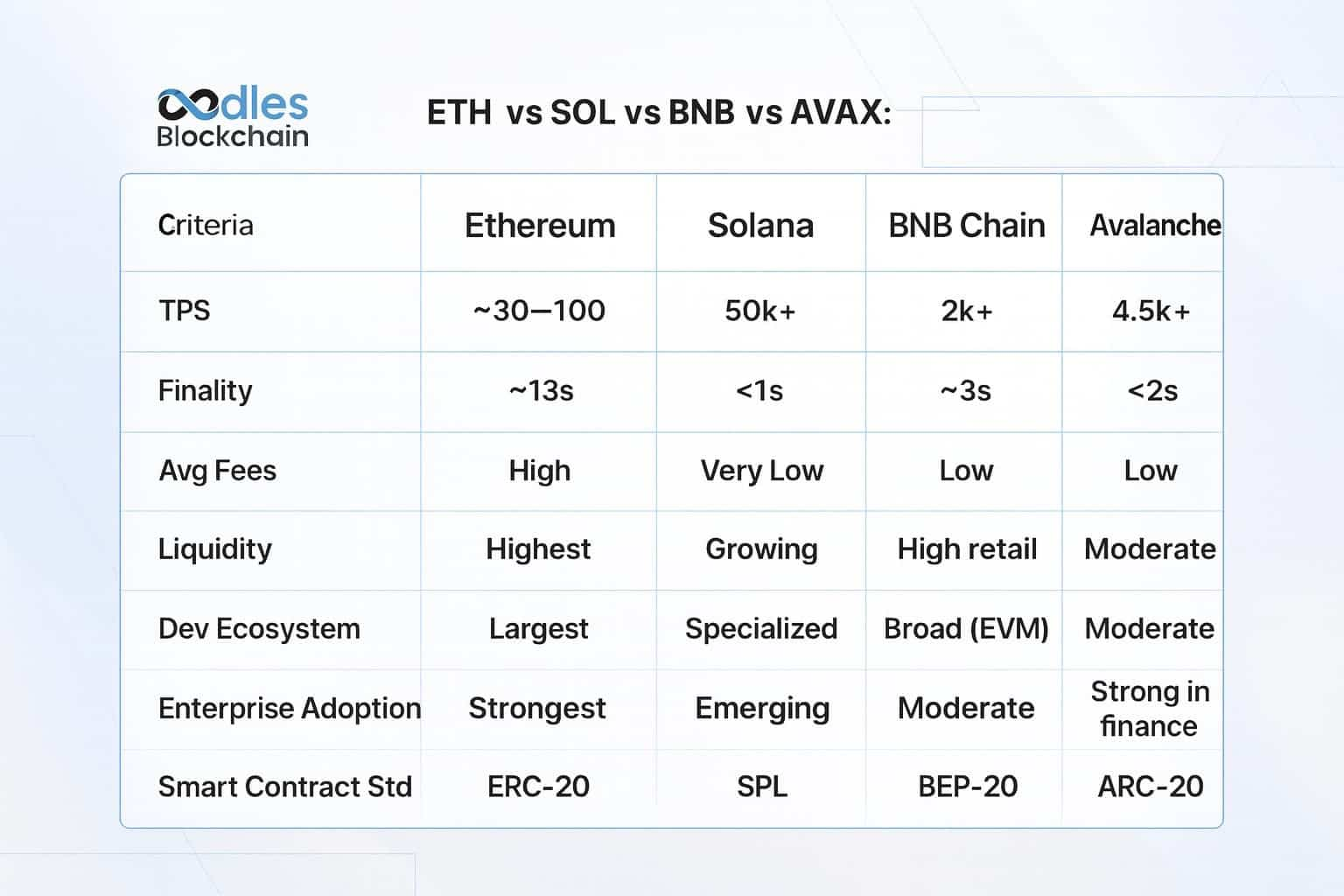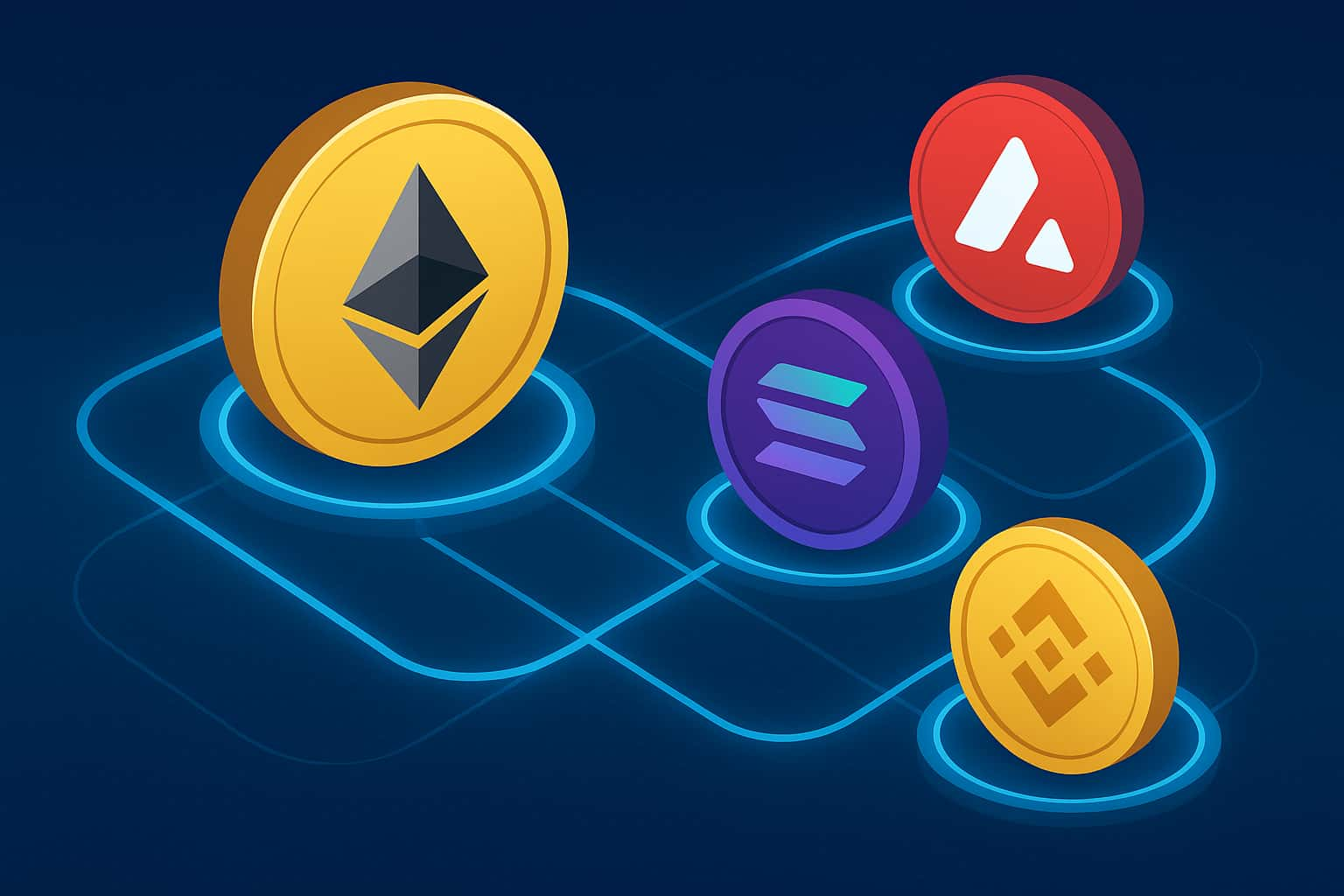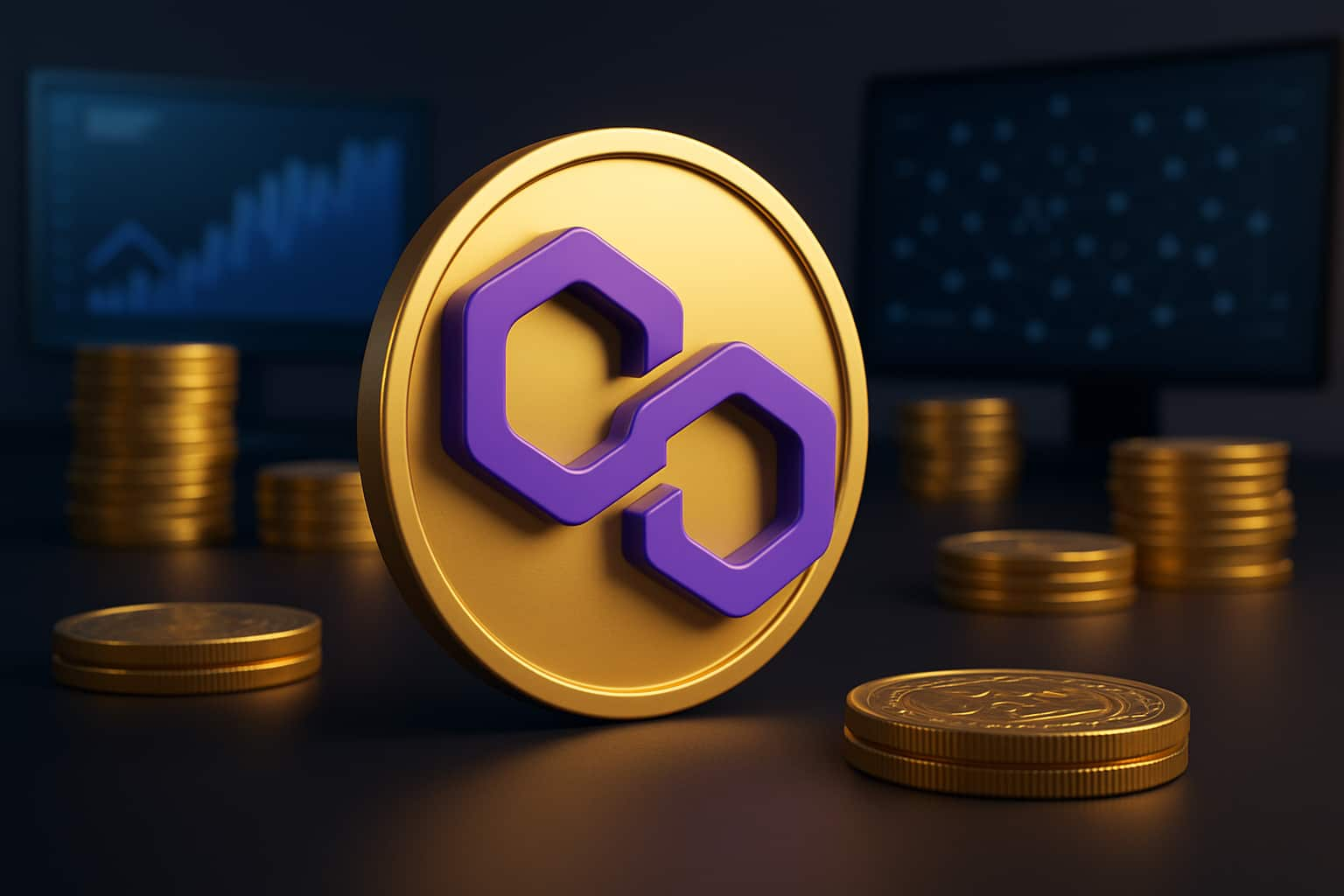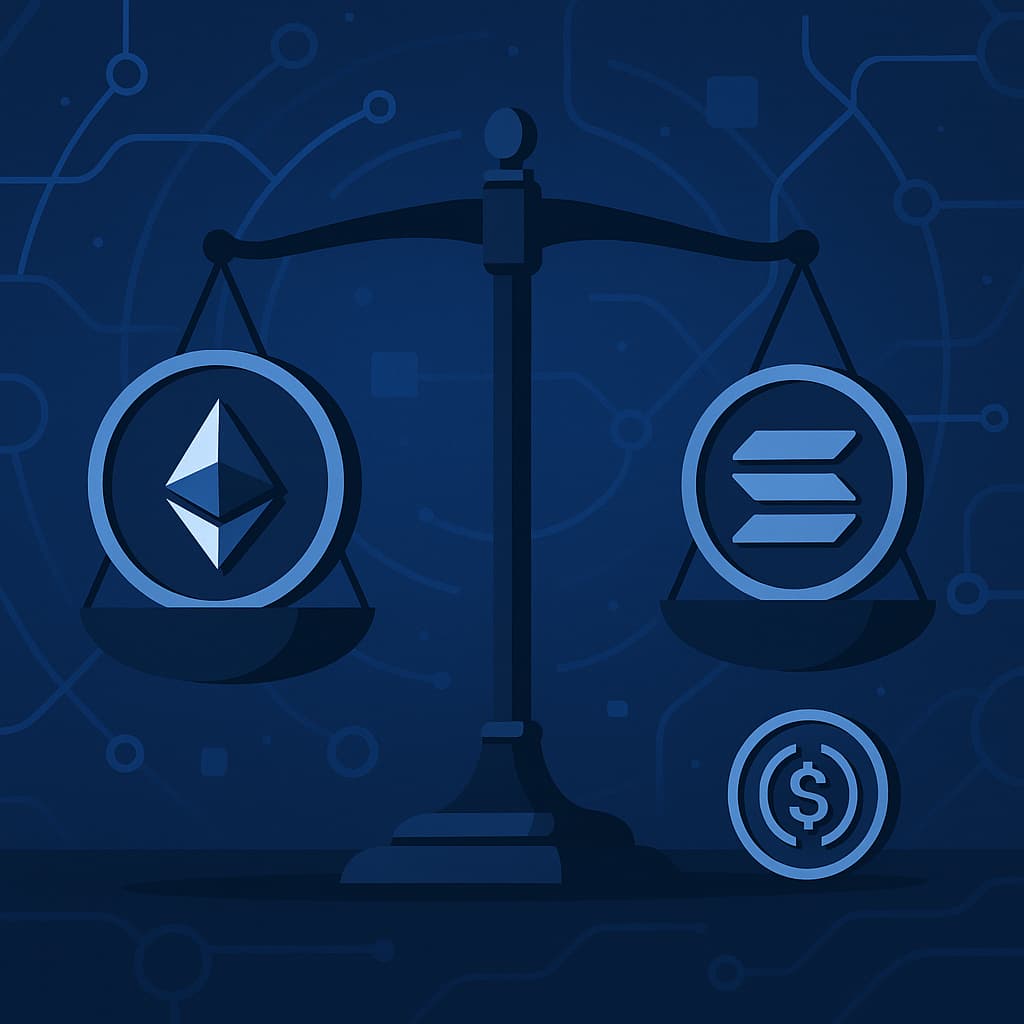-
Choosing the right blockchain determines how far your cryptocurrency can scale, how much liquidity it can access, and how reliably it can handle real-world throughput. Most projects don't fail because of flawed tokenomics, they fail because they choose the wrong chain. If you're evaluating your options or planning to launch a token, start with a solid architectural foundation built by a specialized crypto token development company.
This guide breaks down Ethereum, Solana, BNB Chain, and Avalanche through a technical, business-first lens tailored for founders, CTOs, and enterprise teams deciding where to build.
Why Blockchain Selection Dictates Long-Term Viability
Your choice affects:
- Security and audit posture
- Gas cost at scale
- Exchange listing readiness
- Liquidity depth
- Developer availability
- Future migration cost
Shifting chains later is expensive. Token migrations disrupt holders, invalidate integrations, and require complex re-audits. Get it right upfront.
The Chains That Matter for Cryptocurrency Development in 2025
These four ecosystems dominate enterprise token launches:
- Ethereum: highest trust, most mature infrastructure
- Solana: extreme throughput for consumer-scale products
- BNB Chain: fast execution, retail-heavy adoption
- Avalanche: modular architecture and subnet deployment
Each solves different business constraints. Treat them as infrastructure layers, not interchangeable tech stacks.
You might also like | The Ultimate Guide to Cryptocurrency Development for Businesses
Evaluation Framework for Selecting a Blockchain
A technical evaluation must include:
1. Consensus Model & Security Posture
Security defines audit complexity and institutional acceptance.
2. TPS, Throughput, and Finality
Ignore marketing numbers, what matters is end-to-end reliability under peak load.
3. Gas Fee Predictability
Tokens with high transfer frequency must operate within strict cost ceilings.
4. Developer Ecosystem Maturity
Strong tooling reduces build time and future maintenance risk.
5. Liquidity Access & CEX Support
Exchange readiness is a determining factor for serious tokens.
6. EVM Compatibility
Impacts team hiring, audit frameworks, and cross-chain expansion.
7. Smart Contract Standards
ETH's ERC-20, BNB's BEP-20, SOL's SPL, and AVAX's ARC-20 all have different implications.
8. Regulatory & Compliance Considerations
Institutions care about chain transparency, validator distribution, and operational history.
9. Infrastructure Cost
Node management, validators, RPCs, and monitoring overhead vary by chain.
10. Multi-Chain Expansion Strategy
Modern tokens rarely stay on one chain.
Ethereum (ETH): Institutional-Grade Infrastructure With Long-Term Stability
Ethereum sets the benchmark for security, decentralization, and institutional trust. Its multi-year operational history, extensive audit tooling, and deep liquidity make it the preferred choice for tokens requiring reliability and regulatory alignment.
Core Advantages That Matter in Enterprise Deployments:
- Security First: Ethereum's validator diversity and proven consensus architecture reduce systemic risk.
- Ecosystem Maturity: Battle‑tested tooling, audit frameworks, and developer libraries accelerate secure delivery.
- Liquidity Depth: ERC‑20 assets maintain the widest CEX and DeFi support, ensuring smoother listing pathways.
- Compliance Readiness: Institutional players lean toward Ethereum due to operational transparency and long-lived governance.
Technical Depth:
- Ethereum's state execution model provides deterministic behavior critical for financial applications.
- Mature EVM tooling strengthens audit reliability and interoperability.
- Layer‑2 ecosystems reduce throughput limitations while retaining Ethereum's security guarantees.
Limitations to Consider:
- Gas fees can become significant at scale without Layer‑2 integration.
- Base-layer throughput is lower than next-gen high‑performance chains.
Ideal For: high‑value assets, RWA, regulated tokens, enterprise DeFi, and governance-heavy ecosystems.
You may also like | Utility Token Development Guide for Founders
Solana (SOL): High-TPS Execution Layer for Consumer and High-Velocity Crypto
Solana is engineered for performance, enabling real-time interactions and transaction-heavy ecosystems. Its architecture supports applications that need speed at scale with minimal transaction overhead.
Why Solana Outperforms in High-Demand Environments:
- Massive Throughput: Capable of processing tens of thousands of transactions per second under real workloads.
- Ultra-Low Fees: Enables microtransactions and real-time user interactions without cost barriers.
- Modern Execution Architecture: Parallel transaction processing through Sealevel provides predictable performance.
Deep Technical Insights:
- Rust-based development offers tighter control, improved safety, and fewer attack surfaces.
- Local fee markets (recent upgrades) minimize network congestion spillover.
- Sub-second finality makes Solana ideal for anything requiring instant confirmation.
Limitations:
- Smaller enterprise ecosystem compared to Ethereum.
- Rust expertise is harder to source for large-scale teams.
- Historical downtime, though significantly reduced, affects institutional comfort.
Ideal For: payments, gaming economies, consumer apps, micropayments, event-driven platforms, and appchains requiring ultra-fast execution.
BNB Chain (BNB): Fast Execution and Retail-Focused Adoption
BNB Chain remains one of the most commercially practical platforms for launching tokens targeting rapid user acquisition, low-fee transactions, and mass-market accessibility. Its appeal isn't just low gas, it's the ecosystem gravity created by Binance's exchange network, wallet distribution, and retail-heavy user base.
Why BNB Chain Matters for Token Development:
BNB Chain's architecture (EVM-compatible and optimized for throughput) allows teams to ship faster with predictable costs. Projects targeting high transactional volume, airdrop-driven campaigns, loyalty tokens, lightweight DeFi instruments, benefit from stable fees and straightforward smart contract deployment.Deep Strengths:
- Retail Liquidity Access: Tokens gain visibility across one of the largest CEX ecosystems if they meet listing criteria.
- Predictable Costs: Low, stable gas fees make it suitable for applications with continuous token transfers.
- Fast Development Lifecycle: EVM compatibility shortens build cycles and reduces audit complexity.
- Broad Tooling Support: Existing Ethereum dev tools, SDKs, and frameworks work without friction.
- High Throughput: Suitable for high-frequency operations like staking rewards, referral systems, or transactional utilities.
Technical Considerations:
- Validator set is more centralized compared to ETH and AVAX, which may influence institutional perception.
- Network upgrades and policy decisions are closely tied to Binance's governance cadence.
- Compliance teams evaluate Binance's global regulatory exposure before approving BNB-based deployments.
Limitations:
- Centralization Risk: Fewer validators translates to a weaker decentralization profile.
- Regulatory Sensitivity: Binance-related actions in certain jurisdictions may impact enterprise confidence.
- Moderate Enterprise Adoption: Strong retail traction, but lower adoption among regulated institutions.
Best Fit For:
- Utility tokens targeting mass-market onboarding.
- Projects needing ultra-low gas and high transaction volume.
- Startups aiming for fast go‑to‑market with minimal infrastructure overhead.
- Retail‑driven ecosystems, reward programs, Web3 loyalty, community tokens.
BNB Chain delivers practicality and speed. For teams where cost efficiency and rapid user adoption outweigh deep institutional compliance, BNB Chain provides a high-impact launchpad.
Avalanche (AVAX): Modular Architecture, Custom Subnets, and Institutional Flexibility
Avalanche stands out for its modular architecture, enabling enterprises to deploy purpose-built blockchains (subnets) with fine-grained control over compliance, performance, and validator policies.
Enterprise-Level Capabilities:
- Subnet Flexibility: Customize your own chain, including KYC-gated validators, custom fee structures, and permissioning.
- High Finality and Throughput: Sub-2s finality supports trading systems, settlement layers, and RWA flows.
- EVM-First Development: Full compatibility simplifies smart contract deployment and auditing.
Technical Strengths:
- Independent subnets prevent congestion spillover from the main network.
- Configurable VMs allow application-specific optimization.
- Strong traction in institutional RWA (notable partnerships in 2024–2025).
Limitations:
- Smaller ecosystem than Ethereum.
- Subnet projects require specialized infra deployment, monitoring, and validator orchestration.
Ideal For: financial infrastructure, RWA tokenization, compliance-focused chains, enterprise consortium chains, and high-performance custom networks.
Additional Blockchains Worth Considering
Beyond ETH, SOL, BNB, and AVAX, several chains play a strategic role depending on compliance, cost, interoperability, or geographic adoption.
Polygon (PoS + zkEVM): Enterprise-Friendly, Cost-Efficient Layer-2 Ecosystem
- Ultra-low fees with strong EVM compatibility.
- Broad enterprise adoption (Nike, Starbucks, Meta pilots, large Web2 brands).
- zkEVM architecture supports scalable, secure apps.
Best For: scalable consumer apps, enterprise pilots transitioning to full-scale Web3.
Tron (TRX): Payment-Dominant, Emerging Markets Leader
- Massive user base in APAC and LATAM.
- Extremely low fees and high throughput.
- TRC‑20 tokens dominate USDT stablecoin circulation.
Best For: stablecoins, payment rails, remittance networks.
Near Protocol (NEAR): Developer-Friendly, High-Throughput L1
- Smooth UX, human-readable accounts.
- Focus on WASM smart contracts.
- Strong performance layer for consumer apps.
Best For: onboarding-heavy applications, creator ecosystems.
Polkadot (DOT): Interoperability and Appchain Architecture
- Custom parachains with shared security.
- Strong governance model and institutional research-grade design.
Best For: multi-chain networks, regulated environments needing custom chain logic.
Optimism, Arbitrum, Base (Layer-2 Ecosystem): Ethereum Security at Lower Cost
- Low fees, fast confirmation.
- Full EVM compatibility and rapidly growing ecosystems.
Best For: teams wanting Ethereum-grade security without ETH mainnet gas overhead.
Direct Comparison: ETH vs SOL vs BNB vs AVAX: ETH vs SOL vs BNB vs AVAX

Decision Framework: Which Chain Should You Choose?
Scenario A - Enterprise-Grade Tokenization
Choose Ethereum or Avalanche.
Scenario B - Consumer-Scale, High-TPS Application
Choose Solana.
Scenario C - Retail-Friendly Token with Low Costs
Choose BNB Chain.
Scenario D - Compliance-Focused or Private Environment
Choose Avalanche Subnets.
Scenario E - Multi-Chain Liquidity Strategy
Start with Ethereum, then expand to BNB or AVAX.
Cost Breakdown by Blockchain
Understanding costs upfront helps avoid surprises during audits, deployment, and post-launch maintenance. Below is a realistic breakdown based on current development standards, infrastructure pricing, and audit demand across ecosystems:
- ETH Token ($8k–$25k): Costs rise with audit depth, role-based permissions, staking logic, and integrations with existing DeFi protocols.
- SOL Token ($10k–$30k): Rust development and Solana-specific audits increase pricing. High-performance apps may need custom program logic.
- BNB Token ($3k–$15k): Fastest turnaround and lowest cost due to EVM reusability. Pricing increases if the token includes vesting, tax logic, or multi-chain deployment.
- AVAX Token ($7k–$20k): Pricing aligns with EVM development but increases for tokens interacting with custom subnets.
- AVAX Subnet ($40k–$250k+): Costs vary dramatically depending on validator design, permissioning, KYC layers, custom VMs, high-availability infra, and long-term maintenance SLAs.
These ranges reflect development, testing, audit preparation, infrastructure provisioning, and deployment. Advanced compliance requirements, formal verification, and multi-chain expansion can increase the total cost.
You may also like | The True Cost of Launching a Cryptocurrency in 2026
Common Pitfalls to Avoid
Teams often underestimate non-technical risks that can derail a token's long-term viability. Avoid these frequent failures:
- Choosing based on hype: Chains trending on social media often lack the maturity or infrastructure needed for enterprise-grade products.
- Ignoring liquidity constraints: Some chains have strong tech but weak CEX/DEX liquidity, limiting token adoption.
- Choosing the wrong token standard: ERC-20 vs SPL vs BEP-20 vs ARC-20 heavily impacts interoperability, audit scope, and future expansion.
- Underestimating infra and DevOps cost: RPC endpoints, validators, monitoring, and uptime SLAs require sustained investment.
- Overlooking compliance requirements: Jurisdictional rules, KYC/AML expectations, and audit readiness vary by chain.
- Using theoretical TPS numbers: Real performance depends on network congestion, node quality, and execution model, not headline TPS claims.
How We Help
We operate as an end-to-end blockchain engineering partner, not just a development vendor, supporting enterprises and startups through the full lifecycle of token and blockchain deployment.
Our capabilities include:
- Blockchain architecture selection: We map your business model, compliance needs, and performance targets to the right chain.
- Tokenomics & smart contract engineering: From utility design to advanced mechanics like staking, liquidity locks, or vesting.
- Audit preparation: Architecture reviews, static analysis, best-practice remediation, and audit-ready documentation.
- Node/RPC infrastructure setup: High-availability nodes, load-balanced RPCs, monitoring, and DevOps automation.
- Subnet & appchain deployment: Custom VMs, permissioned validator sets, KYC-gated infrastructure, and enterprise governance design.
- Exchange listing and liquidity planning: CEX/DEX readiness, compliance checks, liquidity provisioning, and market-making coordination.
- Full-stack product development: Wallets, dashboards, staking portals, DeFi modules, or complete blockchain platforms.
We've delivered 200+ blockchain solutions across financial services, supply chain, healthcare, gaming, consumer apps, and Web3 enterprise deployments.
Ready to Choose the Right Blockchain?
- Choosing a chain based on hype instead of infrastructure requirements
- Ignoring liquidity access and CEX readiness
- Underestimating compliance and audit complexity
- Wrong contract standards
- No multi-chain roadmap
- Relying on theoretical TPS numbers
How We Help
We support enterprises and startups across the full crypto development lifecycle:
- Blockchain architecture selection
- Tokenomics and contract design
- Smart contract development and audit preparation
- RPC, node, and infra setup
- Subnet deployment
- Exchange listing and liquidity advisory
- End‑to‑end crypto product development
We've delivered 200+ blockchain solutions across finance, supply chain, healthcare, and consumer Web3.
You may also like | When to Use a Custom Cryptocurrency vs Existing Tokens (ETH, SOL, USDC)
Conclusion: Choosing the Right Chain Is a Strategic Decision, Not a Technical Guess
The blockchain you choose becomes part of your product's foundation, affecting performance, compliance strategy, liquidity, user experience, and long‑term scalability. Ethereum gives you stability and institutional acceptance. Solana delivers the raw throughput needed for high‑velocity consumer apps. BNB Chain offers cost efficiency and retail penetration. Avalanche provides modularity for enterprises needing isolated, compliant execution environments.
Additional ecosystems like Polygon, Tron, NEAR, Polkadot, and Ethereum Layer‑2s fill specific strategic gaps across cost, scalability, and interoperability. The right decision comes from mapping your business model, regulatory environment, and technical constraints against each chain's actual operational strengths, not hype cycles.
If you want a precise recommendation based on your product's architecture, compliance posture, and performance goals, our team can help you evaluate the optimal chain.
Ready to Choose the Right Blockchain?
Book a 30-minute blockchain architecture consultation with senior solution architects at Oodles Blockchain. Get a chain-agnostic assessment covering scalability, throughput ceilings, liquidity pathways, infra requirements, and end-to-end cost projections refined for your product.
If you're evaluating budgets, request a detailed cost estimate for Ethereum, Solana, BNB Chain, Avalanche, or a custom Avalanche Subnet deployment. We have delivered enterprise-grade token, dApp, and infrastructure solutions across every major ecosystem, ensuring your platform is engineered for long-term reliability and compliance.

Our Offices
INDIA
Emaar Digital Greens, Sector 61,
Gurugram, Haryana
122011.
Welldone Tech Park,
Sector 48, Sohna road,
Gurugram, Haryana
122018.












